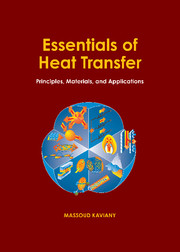Book contents
- Frontmatter
- Contents
- Preface
- Acknowledgments
- Guide to Instructors and Students
- 1 Introduction and Preliminaries
- 2 Energy Equation
- 3 Conduction
- 4 Radiation
- 5 Convection: Unbounded Fluid Streams
- 6 Convection: Semi-Bounded Fluid Streams
- 7 Convection: Bounded Fluid Streams
- 8 Heat Transfer in Thermal Systems
- Nomenclature
- Glossary
- Answers to Problems
- Appendix A Some Thermodynamic Relations
- Appendix B Derivation of Differential-Volume Energy Equation
- Appendix C Tables of Thermochemical and Thermophysical Properties
- Subject Index
Guide to Instructors and Students
Published online by Cambridge University Press: 05 June 2012
- Frontmatter
- Contents
- Preface
- Acknowledgments
- Guide to Instructors and Students
- 1 Introduction and Preliminaries
- 2 Energy Equation
- 3 Conduction
- 4 Radiation
- 5 Convection: Unbounded Fluid Streams
- 6 Convection: Semi-Bounded Fluid Streams
- 7 Convection: Bounded Fluid Streams
- 8 Heat Transfer in Thermal Systems
- Nomenclature
- Glossary
- Answers to Problems
- Appendix A Some Thermodynamic Relations
- Appendix B Derivation of Differential-Volume Energy Equation
- Appendix C Tables of Thermochemical and Thermophysical Properties
- Subject Index
Summary
La poesia
Non é di
Chi la scrive
Ma di
Chi la usa!
– Il PostinoA typical one-semester course syllabus is given in the Solutions Manual. However, at the discretion of the instructor, different parts of the text can be chosen to emphasize various concepts.
Chapter 1 is, in part, descriptive (as opposed to quantitative) and introduces many concepts. Therefore, this chapter should be read for a qualitative outcome and an overview of the scope of the book. This is needed for a general discussion of heat transfer analysis before specifics are introduced. The drawing of heat flux vector tracking is initially challenging. However, once learned, it facilitates visualization of heat transfer, and then the construction of the thermal circuit diagrams becomes rather easy.
Also, to get a broad and unified coverage of the subject matter, a very general treatment of spatial temperature nonuniformity and the appropriate form of the energy equation is given in Chapter 2. This chapter gives the building blocks and the results to be used in succeeding chapters. Some of the energy conversion mechanisms may be new to students; however, they are described in the text and are easy to follow. Application of Chapter 2 materials unfolds in the chapters that follow. For example, various energy conversion mechanisms are used along with heat transfermechanisms in interesting and practical problems.
- Type
- Chapter
- Information
- Essentials of Heat TransferPrinciples, Materials, and Applications, pp. xxiii - xxviPublisher: Cambridge University PressPrint publication year: 2011



